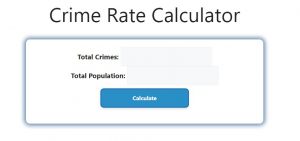About Crime Rate Calculator (Formula)
The Crime Rate Calculator is a valuable tool for analyzing and understanding crime statistics within a specific population. Crime rates provide insight into the safety of a community, allowing residents, policymakers, and law enforcement to make informed decisions. By calculating the crime rate, individuals can better comprehend the prevalence of crime in their area, identify trends over time, and develop strategies to enhance public safety.
Formula
The formula for calculating the crime rate is:
Crime Rate = (Total Crimes / Total Population) * 100,000
Where:
- Total Crimes is the number of reported crimes in a given period.
- Total Population is the population of the area being analyzed.
- The result is expressed per 100,000 people to standardize comparisons across different population sizes.
How to Use
Using the Crime Rate Calculator is straightforward. Follow these steps:
- Gather Data: Collect data on the total number of reported crimes in your area and the total population.
- Input Values: Enter the total crimes and total population into the calculator.
- Calculate: Click the “Calculate” button to obtain the crime rate.
- Analyze the Result: Review the calculated crime rate, which will help you understand the crime prevalence in your area.
Example
Let’s consider a hypothetical city where the total number of reported crimes in a year is 250, and the total population is 50,000.
Using the formula:
Crime Rate = (Total Crimes / Total Population) * 100,000
Crime Rate = (250 / 50,000) * 100,000
Crime Rate = 500
In this example, the crime rate is 500 crimes per 100,000 people, indicating the level of crime in the city.

FAQs
- What is a crime rate?
A crime rate is a measure of the number of crimes reported in a specific area relative to its population, typically expressed per 100,000 people. - Why is the crime rate expressed per 100,000 people?
This standardization allows for easier comparisons between different regions or communities, regardless of their population size. - How often should I calculate the crime rate?
It can be beneficial to calculate crime rates annually or after significant events to monitor trends and changes in crime levels. - Where can I find crime data?
Crime data can typically be found through local law enforcement agencies, government reports, and public crime databases. - Can I use this calculator for different types of crimes?
Yes, you can calculate the crime rate for specific types of crimes (e.g., violent crime, property crime) using the same formula. - How do I interpret a high crime rate?
A high crime rate may indicate a greater prevalence of crime in the area, which could necessitate increased law enforcement or community safety measures. - What factors can affect crime rates?
Factors such as socioeconomic conditions, policing practices, community engagement, and local policies can all influence crime rates. - Is the crime rate the same as the crime index?
No, the crime index is often a composite score that measures the overall crime level based on various factors, while the crime rate specifically refers to the number of crimes per population. - What is considered a “normal” crime rate?
There is no universally “normal” crime rate, as it varies by location, type of crime, and other demographic factors. Comparing local rates to regional or national averages can provide context. - Can crime rates fluctuate significantly from year to year?
Yes, crime rates can vary due to a multitude of factors, including changes in law enforcement practices, economic conditions, and social issues. - How can community programs affect crime rates?
Community engagement programs can help reduce crime by fostering relationships between residents and law enforcement, providing resources, and addressing underlying issues. - Is it possible to reduce crime rates?
Yes, effective crime prevention strategies, community involvement, and adequate resource allocation can contribute to reducing crime rates. - What role does the media play in crime perception?
Media coverage can significantly influence public perception of crime, sometimes exaggerating or downplaying the actual risk in a community. - Can small populations lead to unreliable crime rates?
Yes, small populations can lead to large fluctuations in crime rates, as a single crime can significantly impact the rate. - How do crime rates impact property values?
Higher crime rates can negatively affect property values, as potential buyers may seek safer neighborhoods. - What are the limitations of crime rate data?
Limitations include underreporting of crimes, variations in reporting practices, and differences in legal definitions of crimes. - Are there national crime rate averages?
Yes, national crime statistics are collected and reported by government agencies, providing a benchmark for comparison. - What is the importance of tracking crime trends over time?
Tracking crime trends helps identify patterns, evaluate the effectiveness of interventions, and inform policy decisions. - Can crime rates be affected by law enforcement policies?
Yes, changes in law enforcement strategies, such as community policing, can impact crime rates and reporting practices. - How can I advocate for crime reduction in my community?
Engage with local leaders, participate in community meetings, support crime prevention programs, and promote awareness and education about safety.
Conclusion
The Crime Rate Calculator is an essential tool for anyone interested in understanding crime statistics and trends within their community. By providing a clear method for calculating crime rates, it enables residents, policymakers, and law enforcement to analyze safety concerns and make informed decisions. Regularly assessing crime rates can foster community awareness and contribute to effective strategies for reducing crime and enhancing public safety.
